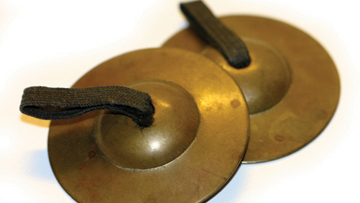You have free articles remaining this month.
Subscribe to the RP Witness for full access to new articles and the complete archives.
As we discussed in last month’s column, God instituted the use of trumpets in worship through Moses. God instituted the use of cymbals in worship through David (1 Chron. 16:4-5; 2 Chron. 29:25). First Chronicles 16:42 indicates that the “trumpets and cymbals [were] for those who should sound aloud.” That is, the cymbals were used along with the trumpets in connection with the daily sacrifices. David also appointed “instruments for the songs of God,” the harps and lyres.
As a part of the sacrificial service, the head of the Levites stood between the sanctuary and the altar with the cymbals. Two priests stood on either side of him with their trumpets. After the sacrifice was on the altar of burnt offering, the priests gave three blasts on their trumpets. The head of the Levites then clashed the cymbals. As the chief priest was pouring the drink offering of wine on the burnt offering, the levitical choir sang the designated psalm of the day. *
There is no indication that cymbals were used to accompany the singing that took place in conjunction with the sacrifices. Their function was similar to that of the trumpets. The cymbals were to “sound aloud.” They are called “loudsounding cymbals” (1 Chron. 15:16, 28; 16:5). To sound aloud is to cause to hear, to proclaim, or to announce.
Isaiah and Nahum use the same word in the same form to describe God’s messengers. “How lovely on the mountains are the feet of him who brings good news, who announces peace and brings good news of happiness, who announces salvation, and says to Zion, ‘Your God reigns!’” (Isa. 52:7, italics added). “Behold, on the mountains the feet of him who brings good news, who announces peace” (Nah. 1:15, italics added). The Apostle Paul connects these texts to preaching (Rom. 10:15).
The loud-sounding cymbals were therefore announcing or proclaiming cymbals. That is, the cymbals, standing with trumpets, symbolized the proclamation or the preaching of the Word in connection with the sacrifice. The response was praise with Psalms.
Notice the three prominent features in this worship setting. The burnt offerings and peace offerings pointed worshipers to Christ. The loud-sounding cymbals and trumpets symbolized preaching about the sacrifice of Christ. There was also praise using selected Psalms.
This use of cymbals in Old Testament worship does not provide a rationale for the use of instruments in worship today. In this light, consider Colossians 3:16: “Let the word of Christ dwell in you richly, teaching and admonishing one another in all wisdom, singing psalms and hymns and spiritual songs, with thankfulness in your hearts to God” (ESV). You must let the message of the sacrifice of Christ live within you. You do this when you take heed to the teaching and counsel you receive in worship in the church. You also do this when you offer praise to God with Psalms in your worship.
Note again these three features of our worship. We place emphasis on the sacrifice of Christ. We teach, preach, and counsel with regard to Christ. We offer Psalms of praise to Christ. So it is that the Old Testament sets forth the manner of our worship today.
- James W. McKinnom, “The Exclusion of Musical Instruments from the Ancient Synagogue,” Journal of the Royal Musical Association, 106:77; John Lightfoot, Collected Writings, Scot, Basset, and Chiswell.
